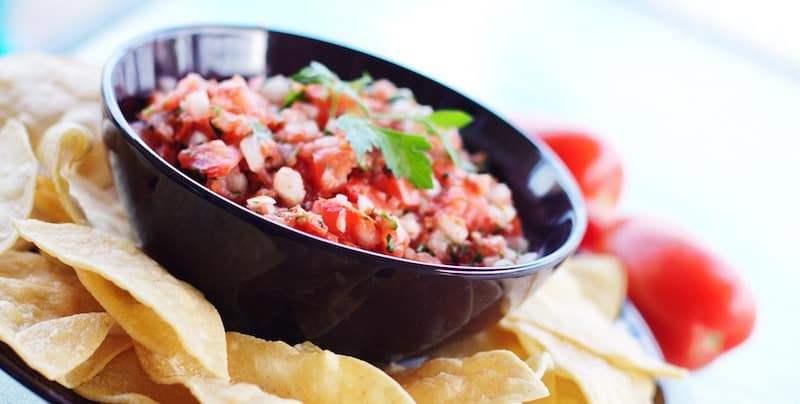While salsa is typically associated with tortilla chips, nachos, and other not-so-Whole30-friendly snacks, there is no reason salsa itself should be left out of your Whole30!
Typically comprised of ingredients like tomatoes, onions, various peppers, herbs and spices, salsa is definitely allowed on Whole30. When buying store-bought varieties, however, you have to remain vigilant with your label reading!
Things to Keep an Eye Out For
When you’re buying salsa at the store for your Whole30, you (as always!) need to make sure you are reading labels to ensure all ingredients are compliant on the program.
Common salsa ingredients that are Whole30 no-go’s include cornstarch, sulfites, and most commonly, sugar!
Much like canned and jarred tomato sauces, people often add sugar to many commercially produced salsas in order to counteract the acidity in the tomatoes. Fortunately for us, though, the core ingredients in salsa are naturally Whole30-friendly, making it not all that hard to find varieties in your favorite grocery store.
Salsa…Hold the Chips
You might be thinking what on earth you can do with your salsa if you can’t dip salty, greasy tortilla chips in it. (Since tortilla chips are made of either corn or flour, they are definitely not allowed on Whole30…bummer!)
Although that is the default way of enjoying this zesty sauce, it is certainly not the only way. Rather than dipping, turn to salsa as a delicious topper for omelets, a sauce to slow cook a pork loin, or a topping to pair with shredded chicken and cauliflower rice!
What Kinds of Salsa Can I Eat on Whole30?
Like we said, keep an eye out for sugar, sulfites, and cornstarch, but most store-bought salsas will be made up of compliant ingredients.
To make life easier, we’ve listed some of our favorites below!
- Trader Joe’s Salsa Verde – This salsa is tomatillo-based and goes amazingly with crock pulled pork! No Trader Joe’s nearby? You can order this one online too!
- Muir Glen Organic Medium Salsa – This classic medium-spicy salsa has a little extra heat—great on top of omelets!
- 365 Everyday Value Organic Hot Salsa – Kick up the heat even more with this one from Whole Foods…or grab another one from their whole line of 365 Everyday Value Salsas—most are compliant (but watch your labels for corn, beans, and other sneaky ingredients!)
Prefer Homemade? Make Your Own!
Whole30 can seem like it takes up a ton of time when it comes to prepping, cooking, and planning out your meals. If you have the time to spare, however, it is totally worth it. When you make your own salsa, you can be absolutely sure there are no non-compliant ingredients inside. Plus, fresh almost always tastes better!
For a simple homemade DIY Whole30 salsa, try throwing a large can of crushed tomatoes, ½ onion of your choice, one bunch of cilantro, a couple of de-seeded jalapeños (depending on your spice preference!), 1-2 cloves of minced garlic, cumin, salt, pepper, and lime juice to taste in a blender and whirr together until combined.
See this recipe from Whole Sisters for their take on a blender salsa and some more in-depth instructions!
What do you think? Do you prefer your salsa chunky or blended smooth? Have a favorite brand or recipe? Leave us a comment and let us know!





I just wanted to let you know all 3 salsa’s you linked have at least 1g of sugar so they are not Whole30 approved. That was a bummer, I thought I had found one I didn’t have to make myself.
The grams of sugar don’t matter – that can occur naturally. You just need to check the ingredient list and ensure that they have no added sugar (aka no sugar listed on the ingredient list)
This doesn’t make clear sense to me. If there is 1 gram of sugar and no added sugars that makes it okay????
Yes, the grams can just be referring to sugars present in the tomato itself, etc. All you need to worry about is the ingredient list.